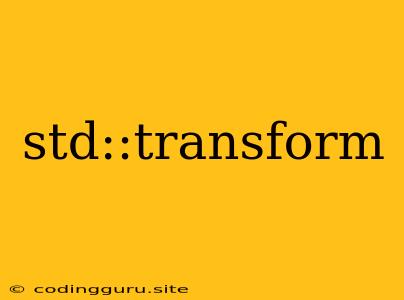Understanding and Utilizing std::transform in C++
The std::transform algorithm in C++ provides a powerful and efficient way to apply a function to every element within a range, transforming the original range into a new one. This article will delve into the workings of std::transform, exploring its syntax, use cases, and practical examples.
What does std::transform do?
At its core, std::transform takes three essential components:
- Input Range: This is the original range of elements you want to transform. It can be a container like a vector, array, or any other range-based object.
- Unary Function (or Binary Function): This function defines the transformation logic. It operates on individual elements from the input range. For unary functions, it takes a single element as input and returns a transformed value. Binary functions, on the other hand, take two arguments: one from the input range and the other from a separate range.
- Output Range: This is where the transformed elements are stored. It could be another container, a different section within the original range, or even a custom iterator.
The Basic Syntax
The general syntax for std::transform is:
std::transform(input_begin, input_end, output_begin, unary_function);
or for binary functions:
std::transform(input_begin, input_end, second_input_begin, output_begin, binary_function);
Example: Squaring Elements
Let's illustrate std::transform with a simple example: squaring every element in a vector.
#include
#include
#include
int main() {
std::vector numbers = {1, 2, 3, 4, 5};
std::vector squares(numbers.size());
// Transform numbers to their squares
std::transform(numbers.begin(), numbers.end(), squares.begin(), { return x * x; });
// Print the squared numbers
for (int square : squares) {
std::cout << square << " ";
}
return 0;
}
In this example:
numbersis our input range, storing the original values.squaresis our output range, where the squared values will be stored.- The lambda function
{ return x * x; }defines our unary function. It squares the input value (x).
Beyond Simple Transformations
The beauty of std::transform lies in its versatility. It can be applied to:
- Performing Arithmetic Operations: You can multiply, divide, add, or subtract elements by a constant value.
- String Manipulation: Convert lowercase letters to uppercase, trim whitespace, or apply other string transformations.
- Custom Transformations: You can create your own complex transformations, such as converting temperatures from Celsius to Fahrenheit.
When to Use std::transform
Consider using std::transform in scenarios where:
- Efficient Iteration: You need to efficiently iterate over a range of elements and apply a specific operation.
- Clear and Concise Code:
std::transformprovides a more readable and maintainable approach compared to manual iteration and element-by-element transformation. - Avoiding Explicit Loops: It allows you to avoid writing explicit loops, reducing code complexity.
Key Advantages of std::transform
- Readability and Conciseness: The syntax is expressive and avoids verbose loop constructs.
- Genericity: It works with various container types and iterators.
- Efficiency:
std::transformis optimized for performance and often outperforms hand-written loops, especially in large datasets.
Exploring Advanced Usage
std::transform can be further customized and extended:
- Using Binary Functions: You can apply transformations based on two input ranges. For instance, combining two vectors element-wise.
- Custom Iterators: You can use custom iterators to define the input and output ranges, enabling flexible transformations.
- Advanced Lambda Functions: Use lambda functions to capture context and perform more complex transformations.
Conclusion
std::transform is a valuable tool in the C++ programmer's toolkit. Its ability to elegantly and efficiently apply functions to ranges of elements makes it a powerful and versatile algorithm. Mastering std::transform enhances your code's clarity, efficiency, and expressiveness, making it a valuable asset for various programming tasks.
